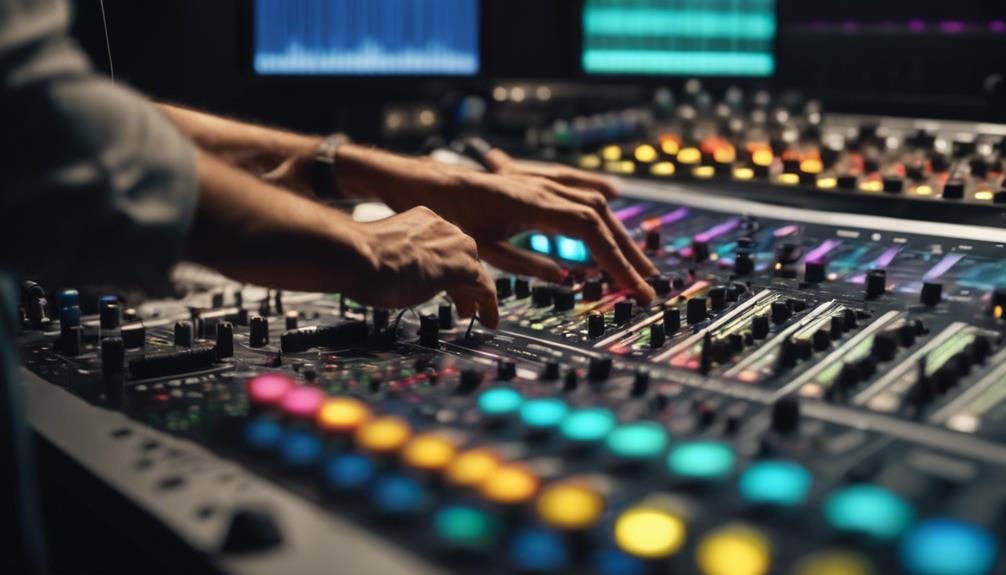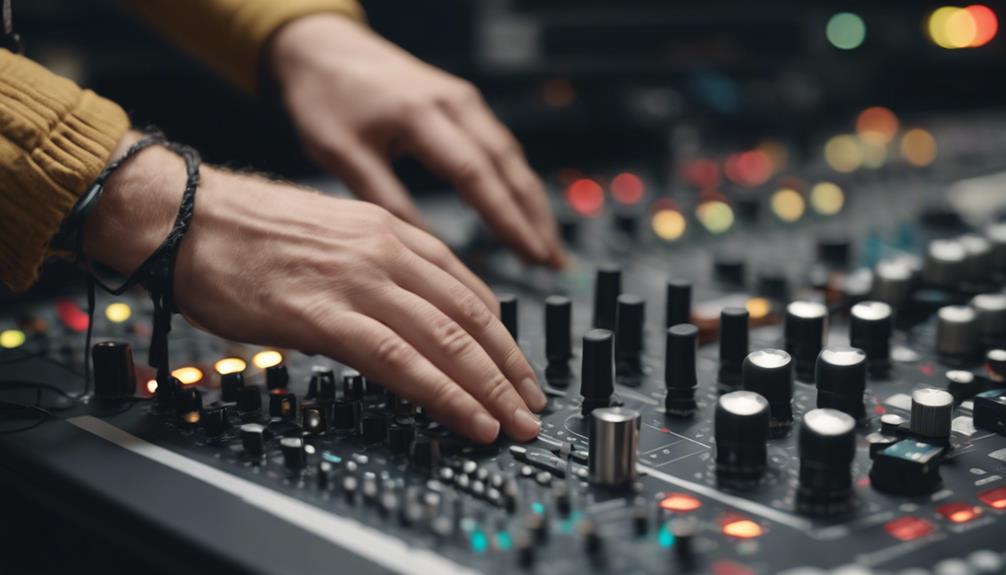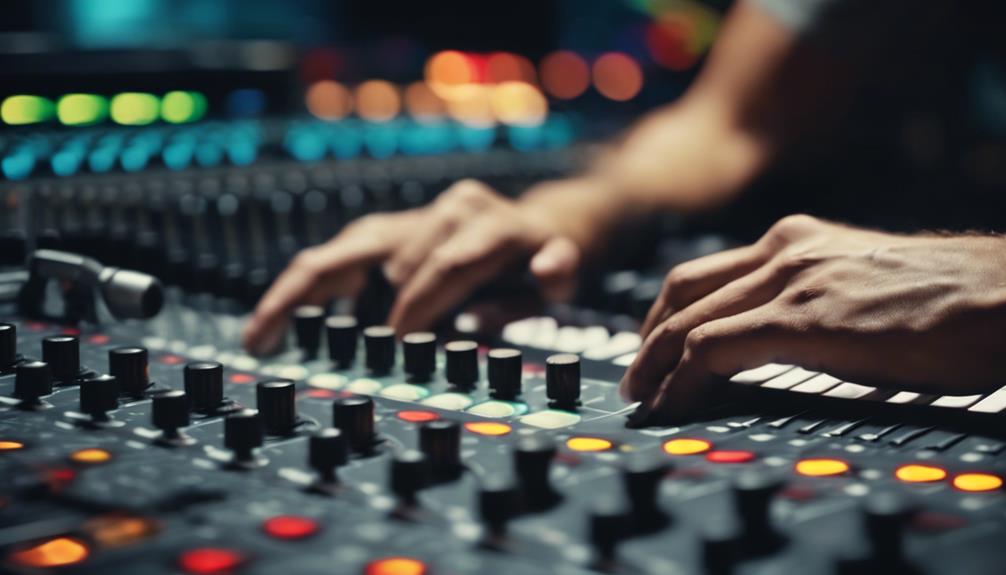Hey there, when it comes to mastering a song like a boss, here are three killer tips to make your tune pop! First up, pump up that dynamic range by using multiband compression to nail that perfect balance between the soft and loud parts. Second, tweak your tonal balance like a pro by playing around with EQ to get those frequencies vibing harmoniously together. Finally, explore enhancing your stereo imaging for a mind-blowing, immersive experience with tools like wideners and panning. Trust us, follow these tips, and watch your song soar to new heights!
Key Takeaways
- Maximize dynamic range using multiband compression for contrast.
- Achieve optimal tonal balance by fine-tuning EQ frequencies.
- Enhance stereo imaging with wideners, panning, and reverb.
- Experiment with EQ settings for genre-specific tonal perfection.
- Check mix in mono to avoid phase cancellation and ensure quality.
Maximizing Dynamic Range
To achieve exceptional sound quality in mastering, we focus on maximizing the dynamic range of the song. Dynamic range is like the superhero cape of music—it's what gives your song that incredible contrast between soft and loud moments. Imagine this: you're at a concert, and the band goes from a whisper to a roar. That's the magic of dynamic range right there!
Now, when it comes to mastering, we don't want to squash all that awesome contrast. That's where tools like multiband compression come into play. They help us make sure the quiet parts are still heard while taming the loud ones. It's like having a volume knob that automatically adjusts to keep things sounding just right.
But wait, there's more! After applying some gain reduction with multiband compression, we might need to add some makeup gain to boost the overall volume. This step is essential in maintaining the balance between the low end and the rest of the frequencies. It's the final touch that brings everything together in harmony.
Achieving Optimal Tonal Balance

Achieving ideal tonal balance in a song involves utilizing EQ to effectively balance frequencies within the mix. Imagine this: your bass, mids, and highs are like a trio performing in perfect harmony. You want each member to shine, but not steal the show from the others. That's where EQ comes in, helping you fine-tune their performance so they complement each other beautifully.
By giving each element its space and clarity, you create a sonic landscape where every instrument gets its moment to shine without overshadowing the rest.
When mastering a song, it's vital to experiment with different EQ settings to find the sweet spot for your specific genre. Whether you're rocking out to some heavy metal or getting down to a funky beat, adjusting the frequencies just right can make all the difference. Don't be afraid to reference tracks from your favorite artists to guide you on the path to tonal nirvana.
With a mix that's balanced to perfection, your song will stand out in the crowd, ready to take on the world!
Enhancing Stereo Imaging
When mastering a song, one key aspect to focus on is enhancing stereo imaging for a more expansive and immersive sound experience. Stereo imaging isn't just about making your music sound wider; it's about creating a sonic landscape that pulls your listeners into the heart of your tunes.
By using tools like stereo wideners, panning to move sounds across the stereo field, and adding just the right touch of reverb, you can take your mix from flat to three-dimensional in no time. The goal here is balanced stereo imaging – think of it as giving each element in your song its own place to shine without overcrowding the mix.
But beware, too much widening can lead to phase cancellation issues and might mess with how your music sounds in mono. Trust me, you don't want your masterpiece to fall apart when heard through a single speaker. So, always remember to check your mix in mono and make sure everything still sounds as awesome as it does in stereo. Keep experimenting, keep listening, and soon you'll master the art of stereo imaging like a pro!
Frequently Asked Questions
How Do You Master a Song Perfectly?
Mastering a song perfectly involves analyzing the frequency spectrum, using EQ to address imbalances, applying compression for control, and utilizing limiting for volume.
We experiment with techniques like stereo widening for enhancement. It's like painting a masterpiece with sound, balancing tones and dynamics to create a harmonious blend.
How Do You Master a Song Like a Pro?
When mastering a song like a pro, we rely on key techniques. We prioritize using reference tracks for guidance and focus on maintaining proper headroom.
By applying metering plugins and building a mastering chain with various tools, like limiters and EQ, we achieve a polished sound. To elevate our mastering, we fine-tune with techniques such as harmonic exciters and parallel compression.
Mastering a song like a pro demands attention to detail and a creative touch.
What Are the Basics of Mastering a Song?
When mastering a song, we focus on enhancing sound quality through EQ, compression, limiting, and stereo techniques. It's all about making the track shine like a gem! We can't fix mix issues, but we sure can make it sound excellent for distribution or performance.
Spending about 30-40 minutes per track is the pro way to go, but stem mastering takes a bit longer due to extra channels. Mastering basics involve mastering the art of EQ, compression, limiting, and the creative side of balancing tracks.
What Should a Mastered Song Peak At?
When mastering a song, it's important to verify that it peaks at around -0.3 dB. This sweet spot helps avoid any unpleasant distortion or clipping, keeping your music sounding clear and professional.
By monitoring those peak levels carefully, we guarantee that our tunes maintain their dynamics and clarity across all systems.
Conclusion
So there you have it, folks! Mastering a song doesn't have to be a challenging task.
By maximizing dynamic range, achieving ideal tonal balance, and enhancing stereo imaging, you can beat any tune that comes your way.
Remember, practice makes perfect, and with these tips in your arsenal, you'll be a master song crafter in no time.
Keep experimenting, keep learning, and most importantly, keep grooving to the music!









